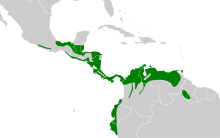Streak-headed woodcreeper
| Streak-headed woodcreeper | |
|---|---|

| |
| Scientific classification | |
| Domain: | Eukaryota |
| Kingdom: | Animalia |
| Phylum: | Chordata |
| Class: | Aves |
| Order: | Passeriformes |
| Family: | Furnariidae |
| Genus: | Lepidocolaptes |
| Species: | L. souleyetii
|
| Binomial name | |
| Lepidocolaptes souleyetii (Lafresnaye, 1849)[2]
| |

| |
The streak-headed woodcreeper (Lepidocolaptes souleyetii) is a
Taxonomy and systematics
The streak-headed woodcreeper has these seven subspecies:[2]
- L. s. guerrerensis Van Rossem, 1939
- L. s. compressus (Cabanis, 1861)
- L. s. lineaticeps (Lafresnaye, 1850)
- L. s. littoralis (Hartert, EJO & Goodson, 1917)
- L. s. uaireni Phelps, WH & Phelps, WH Jr, 1950
- L. s. esmeraldae Chapman, 1923
- L. s. souleyetii (Lafresnaye, 1849)
The streak-headed woodcreeper's

Description
The streak-headed woodcreeper is 19 to 21 cm (7.5 to 8.3 in) long and weighs 23 to 31 g (0.81 to 1.1 oz). It is a slim, medium-sized woodcreeper with a longish, slender, decurved bill. The sexes have the same plumage. Adults of the
The other subspecies of the streak-headed woodcreeper differ from the nominate and each other thus:[4][6][7][8]
- L. s. lineaticeps, crown and underparts streaks narrower than nominate's; rufous of rump, wings, and tail darker, dark brownish maxilla
- L. s. littoralis, like lineaticeps but smaller, paler, less rufescent above and more buffy below
- L. s. uaireni, like lineaticeps but darker overall, more whitish (less buffy) streaks, blacker edges on underparts streaks
- L. s. compressus, like lineaticeps but darker with wider streaks above and below, pale buff to whitish throat
- L. s. guerrerensis, slightly larger, paler red above, grayer below than compressus
- L. s. esmeraldae, deeper buff throat and underparts streaks than nominate, shorter bill
Distribution and habitat
The subspecies of the streak-headed woodcreeper are found thus:[2][4]
- L. s. guerrerensis, Mexico's Sierra Madre del Sur in Guerrero and Oaxaca
- L. s. compressus, from Veracruz, Campeche, and Chiapas in southern Mexico through Central America into western Panama
- L. s. lineaticeps, from Panama's Canal Zoneinto northern and eastern Colombia and western Venezuela
- L. s. littoralis, Trinidad, northeastern Colombia's Atlántico Department and Santa Marta region, central Venezuela, Guyana, and extreme northern Brazil
- L. s. uaireni, southeastern Venezuela's Bolívar state
- L. s. esmeraldae, from southwestern Colombia's Nariño Department south in Ecuador into El Oro Province
- L. s. souleyetii, from southwestern Ecuador's El Oro and Loja provinces into northwestern Peru as far as the Department of Lambayeque
The streak-headed woodcreeper inhabits a variety of wooded landscapes, most of them semi-open to open. These include deciduous and somewhat humid forest, gallery forest, secondary forest, plantations, the edges of humid forest, and open areas with scattered trees. It also locally occurs in mangrove and in arid scrublands. In elevation it reaches 1,500 m (4,900 ft) in Mexico, 1,850 m (6,100 ft) in northern Central America, 1,500 m (4,900 ft) in Costa Rica (though uncommon above 900 m (3,000 ft)), 1,500 m (4,900 ft) in Colombia, and 1,600 m (5,200 ft) in Venezuela. In Ecuador it mostly occurs below 800 m (2,600 ft) but reaches 1,800 m (5,900 ft) locally in Loja Province.[4][5][6][7][8][9]
Behavior
Movement
The streak-headed woodcreeper is a year-round resident throughout its range.[4][10]
Feeding
The streak-headed woodcreeper's diet is mostly non-flying
Breeding
The streak-headed woodcreeper forms pairs during the breeding season but is generally solitary outside it. Its breeding season varies across its range, for example in June and July in Mexico and April to October in Colombia. It usually nests in tree cavities, either natural or excavated by a woodpecker, and pads the bottom with wood chips and bark pieces. It occasionally use nest boxes. Nests in trees are typically 3 to 25 m (10 to 80 ft) above the ground. The clutch size is two eggs. The incubation period is about 15 days; the time to fledging is not known. Both parents incubate the clutch and provision nestlings.[4]
Vocalization
The streak-headed woodcreeper's song has been described as "a simple, descending, clear trill, soft and melodious", "a clear musical descending trill that lasts 1.5-3 seconds", "a high-pitched, thin, flat trill, p'e'e'e'e'e'e'e'eeeaaa, rapid and descending throughout, ca 2-2.5 sec." , and as "a loud, ringing, rapid, descending series of puttering notes: pee'i'i'i'i'i'i'i'i'i'i'i'i'i'i'i'i'ew".[4][5] Its calls include "a harsher, more rattling, shorter trill", "a soft plaintive pyuu", and "a loud, rapidly quavering, descending pee'i'i'u".[4]
Status
The
References
- ^ . Retrieved 8 July 2023.
- ^ Rasmussen, Pamela, eds. (January 2023). "Ovenbirds, woodcreepers". IOC World Bird List. v 13.1. Retrieved 27 April 2023.
- ISBN 978-1-4081-2501-4.
- ^ a b c d e f g h i j Dzielski, S. (2020). Streak-headed Woodcreeper (Lepidocolaptes souleyetii), version 1.0. In Birds of the World (T. S. Schulenberg, Editor). Cornell Lab of Ornithology, Ithaca, NY, USA. https://doi.org/10.2173/bow.sthwoo1.01 retrieved July 8, 2023
- ^ ISBN 978-0-8014-8721-7.
- ^ ISBN 978-0-544-37326-6.
- ^ ISBN 978-0-8014-7373-9.
- ^ ISBN 978-0-19-530155-7.
- ISBN 978-0-9827615-0-2.
- ^ Chesser, R. T., S. M. Billerman, K. J. Burns, C. Cicero, J. L. Dunn, B. E. Hernández-Baños, R. A. Jiménez, A. W. Kratter, N. A. Mason, P. C. Rasmussen, J. V. Remsen, Jr., and K. Winker. 2023. Check-list of North American Birds (online). American Ornithological Society. https://checklist.americanornithology.org/taxa
Further reading
- Skutch, Alexander F. (1969). "Streaked-headed woodcreeper" (PDF). Life Histories of Central American Birds III: Families Cotingidae, Pipridae, Formicariidae, Furnariidae, Dendrocolaptidae, and Picidae. Pacific Coast Avifauna, Number 35. Berkeley, California: Cooper Ornithological Society. pp. 374–384.
External links
![]() Media related to Lepidocolaptes souleyetii at Wikimedia Commons
Media related to Lepidocolaptes souleyetii at Wikimedia Commons
- Streak-headed woodcreeper photo gallery at VIREO (Drexel University)


